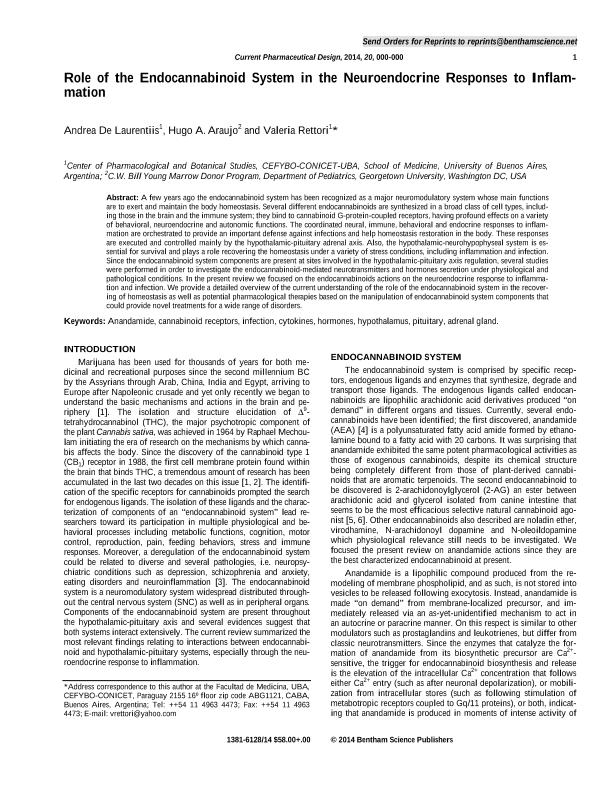Mostrar el registro sencillo del ítem
dc.contributor.author
de Laurentiis, Andrea

dc.contributor.author
Araujo, Hugo A.
dc.contributor.author
Besuhli, Valeria

dc.date.available
2017-03-07T19:01:20Z
dc.date.issued
2014-02
dc.identifier.citation
de Laurentiis, Andrea; Araujo, Hugo A.; Besuhli, Valeria; Role of the endocannabinoid system in the neuroendocrine responses to inflammation; Bentham Science Publishers; Current Pharmaceutical Design.; 20; 29; 2-2014; 4697-4706
dc.identifier.issn
1381-6128
dc.identifier.uri
http://hdl.handle.net/11336/13599
dc.description.abstract
A few years ago the endocannabinoid system has been recognized as a major neuromodulatory system whose main functions are to exert and maintain the body homeostasis. Several different endocannabinoids are synthesized in a broad class of cell types, including those in the brain and the immune system; they bind to cannabinoid G-protein-coupled receptors, having profound effects on a variety of behavioral, neuroendocrine and autonomic functions. The coordinated neural, immune, behavioral and endocrine responses to inflammation are orchestrated to provide an important defense against infections and help homeostasis restoration in the body. These responses are executed and controlled mainly by the hypothalamic-pituitary adrenal axis. Also, the hypothalamic-neurohypophyseal system is essential for survival and plays a role recovering the homeostasis under a variety of stress conditions, including inflammation and infection. Since the endocannabinoid system components are present at sites involved in the hypothalamic-pituitary axis regulation, several studies were performed in order to investigate the endocannabinoid-mediated neurotransmitters and hormones secretion under physiological and pathological conditions. In the present review we focused on the endocannabinoids actions on the neuroendocrine response to inflammation and infection. We provide a detailed overview of the current understanding of the role of the endocannabinoid system in the recovering of homeostasis as well as potential pharmacological therapies based on the manipulation of endocannabinoid system components that could provide novel treatments for a wide range of disorders.
dc.format
application/pdf
dc.language.iso
eng
dc.publisher
Bentham Science Publishers

dc.rights
info:eu-repo/semantics/openAccess
dc.rights.uri
https://creativecommons.org/licenses/by-nc-sa/2.5/ar/
dc.subject
Anandamide
dc.subject
Cannabidnoid Receptors
dc.subject
Infection
dc.subject
Cytokines
dc.subject
Hormones
dc.subject
Hypothalamus
dc.subject
Pituitary
dc.subject
Adrenal Gland
dc.subject.classification
Neurociencias

dc.subject.classification
Medicina Básica

dc.subject.classification
CIENCIAS MÉDICAS Y DE LA SALUD

dc.title
Role of the endocannabinoid system in the neuroendocrine responses to inflammation
dc.type
info:eu-repo/semantics/article
dc.type
info:ar-repo/semantics/artículo
dc.type
info:eu-repo/semantics/publishedVersion
dc.date.updated
2017-03-06T15:25:45Z
dc.identifier.eissn
1873-4286
dc.journal.volume
20
dc.journal.number
29
dc.journal.pagination
4697-4706
dc.journal.pais
Emiratos Árabes Unidos

dc.journal.ciudad
Sharjah
dc.description.fil
Fil: de Laurentiis, Andrea. Consejo Nacional de Investigaciones Científicas y Técnicas. Oficina de Coordinación Administrativa Houssay. Centro de Estudios Farmacológicos y Botánicos; Argentina. Universidad de Buenos Aires. Facultad de Medicina; Argentina
dc.description.fil
Fil: Araujo, Hugo A.. University Of Georgetown; Estados Unidos
dc.description.fil
Fil: Besuhli, Valeria. Consejo Nacional de Investigaciones Científicas y Técnicas. Oficina de Coordinación Administrativa Houssay. Centro de Estudios Farmacológicos y Botánicos; Argentina. Universidad de Buenos Aires. Facultad de Medicina; Argentina
dc.journal.title
Current Pharmaceutical Design.

dc.relation.alternativeid
info:eu-repo/semantics/altIdentifier/url/http://www.eurekaselect.com/120077/article
dc.relation.alternativeid
info:eu-repo/semantics/altIdentifier/doi/http://dx.doi.org/10.2174/1381612820666140130212957
Archivos asociados
